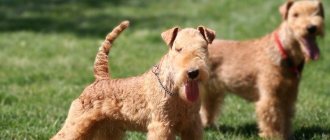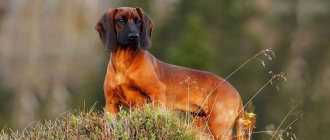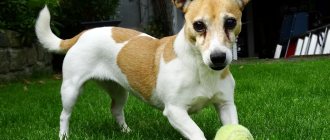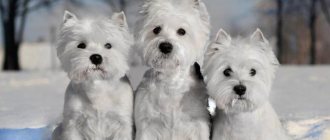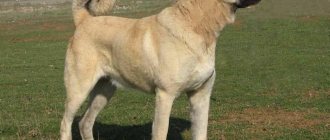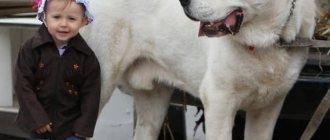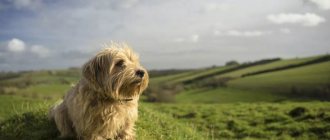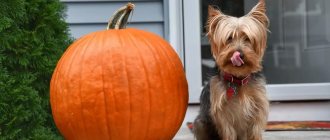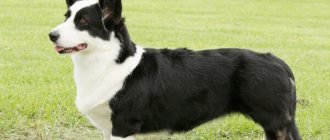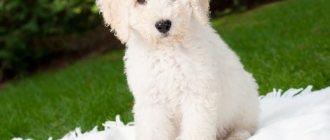The Lakeland Terrier is one of the descendants of the Bedlington Terrier, intended for hunting small animals. Today, the hunting qualities of this dog have faded into the background; more and more often it appears in the role of everyone’s pet. Lakeland Terriers are not only friendly and loyal companions, but also fearless protectors who can protect their owner from trouble. They are active and energetic, so it is easy to take long walks, play sports and even travel with them.
Breed traits
Breed traits (on a 5-point scale)
| Lakeland Terrier | |||
| Activity | in the house | 4.3 | |
| on the street | 4.3 | ||
| Obedience | training | 2.8 | |
| strangers | 3.3 | ||
| Domination | in family | 2.3 | |
| over dogs | 3.8 | ||
| Defending your territory | from people | 2.3 | |
| from dogs | 3.5 | ||
| Sociability | in family | 4.8 | |
| with strangers | 3.8 | ||
| with dogs | 2.8 | ||
| Concentration | in family | 2.3 | |
| in front of strangers | 2.8 | ||
| with dogs | 2.3 | ||
| Aggressiveness | in family | 1.5 | |
| to strangers | 2.3 | ||
| to the dogs | 3.5 | ||
| to cats | 3 | ||
| Family behavior | calmness | 3.8 | |
| demand for affection | 3 | ||
| excitability | 4.8 | ||
| playfulness | 5 | ||
| excessive barking | 3.3 | ||
| behavioral breakdowns | 2.5 | ||
| Tolerance for children | up to 4 years | 4 | |
| over 4 years old | 4.3 | ||
| Institutional use | watchman | 3.8 | |
| bodyguard | 2.3 | ||
This breed is often compared to the following dog breeds: Welsh Terrier, Wirehaired Fox Terrier, Airedale Terrier, Irish Soft Coated Wheaten Terrier (Whiten Terrier), Miniature Schnauzer (Dwarf Schnauzer).
Pictured are Lakeland Terriers:
About the habitat
This breed feels good in the wild, but after taming by humans, many individuals became completely tame. However, you can keep a terrier outside. True, for this you should take care of the dog’s place of residence. But the Lakeland Terrier also feels good in the apartment. Photos of individuals used for selective selection can be found in this article. Exhibition specimens cannot be kept outside all year round, especially in low temperatures and poor conditions. This is due to a large number of reasons. The dog's character, coat quality, and much more change.
General characteristics of the Lakeland Terrier breed
This breed was formerly called the Patterdale Terrier. The name “Lakeland Terrier” appeared only in the 20th century and is translated as “Lakeland Terrier”. These are medium-sized dogs, one of the terrier varieties. They were bred to protect farms from rodents and to hunt burrowing animals.
Externally, these dogs are similar to Airedale Terriers and Welsh Terriers. Lakelands differ from them in growth and temperament. They have a less massive build and high legs, thanks to which they can develop greater speed. Unlike Welsh Terriers, they are almost non-aggressive, people-oriented, and easier to train.
| Options | Characteristic |
| breed name | Lakeland Terrier |
| a country | Great Britain |
| breed group | terriers |
| application | hunting, sports, companions |
| life expectancy | 12-15 years |
| height | up to 37 cm |
| weight | up to 8 kg |
| character traits | cheerfulness, excitement, fearlessness, friendliness, devotion |
| appearance features | strong build, high legs, rectangular muzzle, hard, dense coat |
| colors | black and tan, blue, saddle cloth, grizzly, wheaten |
| aggression | average |
| activity | high |
pros
Due to their small size, Lakeland Terriers easily get along in a city apartment. They are unpretentious, their fur hardly sheds, does not emit a dog smell and does not cause allergies. This dog is perfect for an active owner; it will accompany him on hikes and enjoys playing sports. Representatives of the breed are person-oriented and sense their mood. They have several more advantages:
- good guard qualities;
- easy to train, suitable for inexperienced owners;
- sociable, cheerful;
- loyal, attached to the owner;
- vigilant, discerning;
- smart and quick-witted;
- hardy, efficient.
Minuses
But Lakeland Terriers are hunting dogs. They were specially bred to kill rodents. This left an imprint on their character and behavior. Most of the disadvantages of the breed are associated with these features:
- they chase birds and cats on the street;
- do not get along with other pets, especially rodents;
- need high physical activity;
- cannot tolerate loneliness and lack of attention;
- bark a lot;
- often conflict with other dogs.
Interesting facts about Welsh Terriers
Welsh Terriers are active dogs with a willful character. They are often cocky and do not miss the opportunity to make a scandal or have fun. They love to be the center of attention and are not ready to share primacy in the family, even with children. In addition, Welsh Terriers have a number of interesting qualities that everyone can appreciate in their own way.
The Welsh Terrier dog breed is quite actively used by hunters as universal dogs. The Welsh Terrier can grab prey, drive it into a corner, bark, or bring back a bird that has already been shot. These dogs are indispensable for hunting. Some hunters note that some dogs are better at hunting badgers, while others are better at hunting foxes. In terms of hunting, they resemble German pinschers.
At the beginning of their existence, Welsh Terriers were used as hunters for burrowing small animals. Subsequently, their use became wider, and guarding and shepherding qualities appeared. Today, representatives of the breed have become excellent companions for people. They are deservedly included in the TOP 10 small hunting dogs.
Welsh Terriers are always in high spirits. They are ready to play and have fun, despite their elegant, aristocratic appearance. Welsh Terriers need a proper training program. This way you can protect the furniture in your house from the constant attacks of these active dogs, and also allow the breed to develop competently. Training is not very difficult, but it needs to be done.
History of the origin of the Lakeland Terrier breed
The breed was developed in the rocky terrain of the Lake District. Farmers needed a compact and hardy dog that could crawl into narrow holes and crevices and run over boulders. But she also had to be strong and fearless in order to resist the foxes, from whose raids the farms suffered. To achieve this, dog breeders began to cross different types of terriers: Bedlington, Dandie Dinmont, Wirehaired Black and Tan, Border, Fox Terrier. The longest-legged and narrow-chested individuals were selected. They were dexterous, jumping, and passionate.
At first these dogs were called Patterdale Terriers. They were popular in peasant farms and were used for burrow hunting. In 1912, the first breed club was created, and dogs began to participate in exhibitions. After some time, the breed was officially recognized and called the Lakeland Terrier. By the middle of the 20th century, these dogs spread throughout the world and became popular. But they appeared in Russia only in 1998. This breed is still little known in our country.
Training
Lakelands are highly trainable, as long as the training is done daily and is not too repetitive. From the first days a puppy appears in your home, start teaching him simple commands: “no”, “place”, “lie down”, “sit” and others that are necessary to establish mutual understanding with your new friend.
Classes with the puppy should not last more than half an hour. It is advisable to interrupt classes so that the puppy rests every quarter of an hour. Lakelands are cheerful and very active dogs, so their training should not be carried out in one place for a long time. These animals need movement. After mastering the basic commands, begin sports activities. Mini-agility competitions are suitable for Lakelands.
Appearance of the Lakeland Terrier
Lakeland Terrier dogs have a lean, wiry build. They have long legs and dense, coarse fur. They are classified as medium terriers, but unlike most representatives of these breeds, their height does not exceed 37 cm. They weigh on average 6-8 kg, regardless of gender.
Head
The head is medium in size, the muzzle is rectangular, not long. The skull is flat, moderately wide. The stop is almost invisible. The lobe is large and black. If the color is shabby or wheaten, a brown nose is allowed. The jaws are powerful, capable of holding a fox or otter. The teeth are large, scissor bite.
The eyes are small, oval, widely set. The color of the iris is dark. The look is inquisitive, cheerful. The ears are small, set high and quite close to each other. They are V-shaped, raised at the base, and hanging from the middle. The tips of the ears reach the outer corners of the eyes, the inner edge is pressed to the head.
Frame
The body is proportionally folded, square format. The neck is long, goes into steep withers, without dewlap or folds. The back is short, flat, the chest is narrow, deep, the stomach is slightly tucked. Thanks to this, the dog can fit into any gap that the head fits through. The tail is set high, usually carried vertically, with a slight bend. It is customary to dock it, but not short. The tail should not curl over the back or droop down.
Limbs
The limbs are long and muscular. The front ones are straight, set vertically. The shoulders are laid back, the shoulder blades are located close to each other. The hindquarters are muscular, strong, laid back. The ischial tuberosities and joints are well defined. The paws are small, rounded, the toes are arched, with thick pads. The dog is agile, runs fast, and is able to overcome difficult places.
Wool
Lakeland Terriers have a hard coat and a soft, dense undercoat. The outer hair is straight, coarse, wiry, 2-3 cm long. On the face and limbs the hair is thicker. There it may curl slightly. The legs are profusely pubescent, and the head has a characteristic bang and beard.
Colors
The standard for this breed allows different types of colors. They can be plain or with a saddle. The most common solid colors:
- ginger;
- wheat;
- black;
- blue;
- hepatic;
- grizzly.
Dogs of any color can have a saddle or dark back. Only dark brown or brownish-red colors are not allowed. White spots are not desirable.
Photos complement the description of the appearance:
Character traits
The character and temperament of Lakelands is typical of terriers. These are active, easily excitable, mobile dogs. They are gambling and love active games. A strong hunting instinct makes them run outside after birds and small animals. They often conflict with other dogs, trying to prove their superiority. They do not get along with any pets.
But unlike other hunting dogs, Lakelands do not show aggression towards humans. They become strongly attached to their owner and family members, affectionate and obedient. They easily adapt to the lifestyle and character of the owner, and are suitable for any person who will pay attention to them and provide physical activity. These are pets who love when people pay attention to them and praise them, but they do not impose themselves or get into your hands. They cannot stand loneliness or change of owner, and may even get sick.
Lakelands love children and support all games. This is an excellent family dog, but it will not be a nanny; it is better to get one if the child is older than 3-5 years. The dog will not tolerate being dragged by the tail and ears or having his toys taken away. Therefore, it is necessary to explain to the child the rules of communication with a dog.
These terriers are mischievous, cheerful, love to play pranks and run. They are very addicted, which can make training difficult. But they have a strong territorial instinct and protective qualities. They are vigilant and are wary of strangers, although without aggression. But they always warn the owner by barking about the approach of strangers and about danger.
The Lakeland Terrier is a dog with the following character traits:
- fearless;
- cheerful;
- gambling;
- self-confident;
- purposeful
Education and training
Representatives of this breed are very smart and quick-witted. Therefore, they easily learn different commands and can learn tricks. But training may be difficult due to the active temperament and curiosity of the dog. She is often distracted and can be stubborn, so you need to be patient and persistent. You should never yell at your pet, much less hit him. Positive results in education can only be achieved with affection and encouragement.
Lakeland needs to be socialized from an early age, accustomed to street noise, strangers, and strange dogs. Training should be short and interesting. It is recommended to conduct them in the form of a game. Terriers do not tolerate coercion, monotony, or frequent repetition of one command. Another feature of representatives of this breed is that they are owners. Therefore, you should not wean them from protecting their toys or place.
Basic moments
- In Ireland, this variety of terrier is called “red devils” and “daredevils”.
- Like all representatives of the terrier group, the Irish are quite hot-tempered. Nevertheless, stories about them as ferocious fighters and provocateurs are greatly exaggerated.
- The Irish Terrier is a real “universal soldier”, capable of not only chasing wild boars through the forest, but also guarding the estate, working as a search engine and even setting sports records.
- The breed was never particularly promoted, so commercial breeding bypassed it. As a result: all Irish terriers have excellent health and a stable psyche.
- Despite their explosive temperament and gambling, Irish Terriers are smart students who quickly learn even the most complex material and successfully apply it in practice.
- Irish Terriers are easy to travel with: the breed is mobile and easily adapts to any environmental conditions.
- Young Irish Terriers are very energetic, so they need a long walk: at least 2.5-3 hours a day.
- These red “daredevils” have retained all the inherent qualities of terriers, so be mentally prepared for digging trenches in lawns, chasing stray cats and other canine “sabotage.”
- The breed needs systematic trimming, since seasonal shedding is not a problem for Irish Terriers.
- For those who are getting their first dog, the “Irish” is the worst possible option, because such a wayward pet can only be trained if you have experience working with terriers.
The Irish Terrier is a dog that can change its mood and behavior style like gloves, but is incredibly stable in its own love for its owner. Temperamental, quick to turn on, this redhead is a real genius of transformation, easily mastering the main canine professions. No matter what important mission he is entrusted with, the “Irishman” will definitely try to exceed the plan in order to earn the coveted praise. At the same time, the Irish Terrier is far from a simpleton, and sometimes a completely unpredictable intriguer, capable of the most unexpected attacks. And yet, curbing and directing the animal’s energy in the right direction is a completely feasible task, especially if you have already dealt with terriers and are aware of their breed “tricks”.
Maintenance and care
Lakeland Terriers are very active dogs. They are ready to run all day long and love outdoor games. Due to their small size, they can be kept in a city apartment or private house, but it is necessary to provide them with sufficient physical activity. It is advisable to take them for walks in the park more often, go to the river, and take them to dog parks. This dog will be happy to accompany you on a hike, a car trip, or accompany a bicycle.
Caring for representatives of this breed is easy. The coat hardly sheds, but like other wire-haired terriers it needs trimming. It is done from 6 months of age every 2-3 months.
Otherwise, your pet will require the following hygiene procedures:
- Brush the coat 2-4 times a week with a stiff brush or a fine-toothed metal comb;
- bathe the dog 1-2 times a month using special shampoos;
- Wash or wipe paws after every walk;
- the muzzle needs to be washed after every meal;
- It is recommended to regularly trim the hairs along the contour of the lips and on the paws;
- examine and clean your ears once a week;
- wipe your eyes daily;
- shorten claws every month;
- brush your teeth several times a week with a special paste or give chewy treats;
- Regularly treat the wool with antiparasitic agents.
Nutrition
Breeders recommend feeding the Lakeland Terrier with ready-made food. You need to choose those that are designed for active dogs. It is important that they are not lower than premium class.
With a natural diet, your pet should be given at least 250 g of lean meat every day. It is supplemented with cereals and vegetables. It is useful to give kefir, cottage cheese, eggs, vegetable oil, and herbs. On the recommendation of a veterinarian, vitamin complexes are added to food.
Health
Lakeland Terriers are in good health. With proper care, they live up to 15-16 years. Only occasionally do representatives of the breed experience the following diseases:
- joint dysplasia;
- cataract;
- hypothyroidism;
- blood clotting disorder.
Nutrition
The dog's diet should be balanced. That is, along with food, the dog should receive carbohydrates, proteins and fats, vitamins and microelements. Therefore, you can give your dog meat, cottage cheese and fish. Eggs will also be useful for your pet. The meat offered to the dog should not be fatty. It could be turkey, rabbit or beef. You can add milk to your Lakeland Terrier’s diet, preferably along with porridge or bread. Porridge is always cooked in water, milk is added at the very end of cooking. The animal will benefit from fruits, vegetables and herbs, which are the main sources of vitamins. Food is served in crushed form.
How to buy a Lakeland Terrier puppy
This breed is not very popular in Russia, but you can find kennels in Moscow and other large cities. It is recommended to reserve your puppy in advance as there may be a waiting list. A purebred dog in a good kennel costs 40-50 thousand rubles. Only puppies without a pedigree are sold cheaper.
When choosing, you need to pay attention to the breed characteristics, activity of the puppy and its state of health. There should be no discharge from the eyes, dandruff, or a bloated stomach. A healthy baby has a moist nose, no unpleasant odor, and stands confidently on his feet.
The photo shows what the puppies look like:
An interesting video complements the description of the breed:
Video: Lakeland Terrier. Breed characteristics, care
Lakeland Terriers are loyal companions, mischievous and cheerful pets. They are unpretentious, easy to train and do not show aggression. But this dog should become a member of the family, it needs to be given enough attention, then it will be obedient and will not cause problems.
Diseases
The Lakeland Terrier has a lifespan of 12-16 years and has minor health problems. The breed may suffer due to:
- lens luxation;
- prognathism;
- hypothyroidism;
- distichiasis;
- Legg-Perthes disease;
- von Willebrand's disease.
The Lakeland Terrier should also undergo regular eye examinations.
